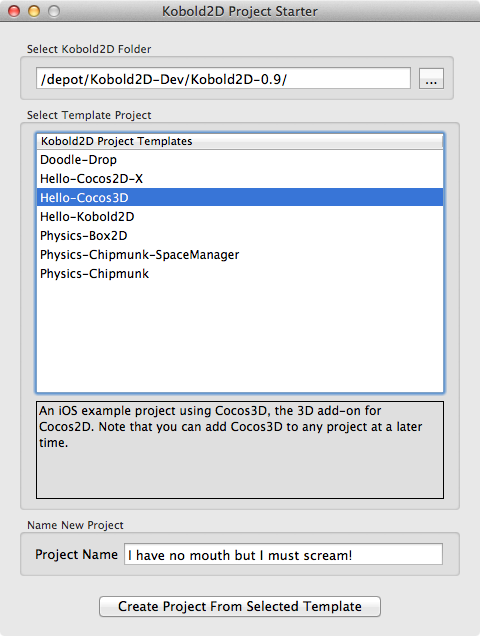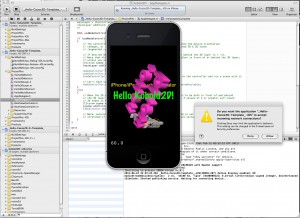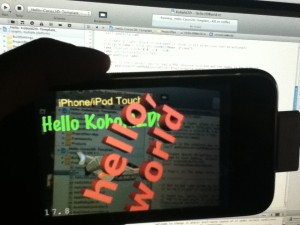
Example ARC project. Pretty awesome.
Therefore I decided to enable ARC in all twelve standard cocos2d Xcode project templates for both cocos2d versions (v1.1 and v2.0), both platforms (iOS and Mac OS), both physics engines (Box2D and Chipmunk) and publish them on github.
You can download the ARC-enabled cocos2d template projects either as ZIP file or TAR file.
The Goal
Kobold2D users should never have to run a bash script, ever. Any project or asset management task most users will want to perform should be done with a visual tool.
The Problem
I mentioned before that I had problems turning the Kobold2D project templates into the Xcode 4 Project Template format. In fact, it turned out to be impossible due to the nature of Kobold2D’s workspace setup.
Since I want to have a wide variety of project templates in Kobold2D, and definitely more than the three rudimentary templates that cocos2d-iphone offers, I needed some way to allow users to start new projects based on a template.
The Solution
What I came up with is the Kobold2D Project Starter Tool:
Simple and elegant. This tool scans the projects in Kobold2D templates folder, which are regular Xcode projects with a common naming scheme (eg. _Hello-Kobold2D-Template_), and presents them to the user including a description.
Select a project template, give it a name and click Create. The tool will copy the template project to the Kobold2D folder next to all the other projects. All occurrences of _XXXX-Template_ are renamed to the user supplied project name (which is cleaned to remove illegal characters). Then the project is added to the Kobold2D.xcworkspace which the tool will open right away.
The Benefits
I think the biggest benefit by far is that anyone can turn his or her Xcode project into a template, simply by following the naming scheme. Anyone can create and distribute their own Kobold2D project templates.
Note: in the screenshot there are only 7 templates listed. I’ll definitely add more for the Kobold2D v1.0 release, most will be based on projects discussed in my Learn Cocos2D book. The first preview version (v0.9x) of Kobold2D will be available in about two weeks.
Today I completed the first draft of the Kobold2D chapter which will be in the second edition of the Learn Cocos2D book. In that chapter I’m also giving you an introduction to cocos3d, the official 3D add-on library for cocos2d. I ported cocos3d’s Xcode project template to Kobold2D and spiced it up a little with some cocos2d nodes in the back- and foreground:
Notice the “incoming network connection” warning. This is caused by the iSimulate library which is distributed with Kobold2D and activated by default for Simulator builds. You still need to buy the iSimulate App to benefit from it though. If you don’t you can also choose to ignore the dialog or simply disable iSimulate by commenting out a line in the project’s BuildSettings-iOS.xcconfig file.
I’ve also had great fun with the augmented reality option that the cocos3d CCNodeController class provides. And setting it up is one line of code. Here’s the “camera as live background” demo in action:
Since a picture doesn’t really do it justice, here’s a video:
Admittedly it could run a little faster on my iPhone 3G. It’s pretty taxed and averages around 20 fps with the camera background view and rendering a 3D model. My iPod Touch 4 averages at around 40 fps and it feels a lot smoother.
Kobold2D Todo List
One of the biggest items on my todo list for Kobold2D is to design the website and get rid of the “coming soon” page. This includes setting up the wiki and filling it with content, documentation for the most part. And, well, paying $150 each month because I don’t see any alternative to using Confluence. I want to enjoy working on documentation, and I want you to enjoy browsing and reading it.
I also want to create more template projects. Currently, as you can see in the first screenshot, there’s Hello Kobold2D (iOS & Mac), Hello Cocos3D (iOS) and Hello Cocos2D-X (iOS). I want to add two more templates, one for Chipmunk with SpaceManager (iOS & Mac) and one for Box2D (iOS & Mac). I also want to add the projects from my book as project templates, namely Doodle Drop, the Shoot ’em Up game, the Orthogonal and the Isometric Tilemap projects, and the Cocos2D With UIKit project (all iOS).
Even though Kobold2D won’t have Xcode 4 Project Templates I still want to give you a quick and easy way start a new project based on one of the template projects. Notice the distinction between “project template” (those in Xcode’s New Project dialog) and “template project” (a regular, already existing project). I started writing a tool that allows you to create a copy of an existing Kobold2D template project and rename it, so that the workflow is just as convenient as doing it within Xcode. It works for the specific template I tested it with, but I still have to design the user interface and make the code fail-safe.
In case you wonder why Kobold2D won’t have Xcode Project Templates: they are not nearly as powerful as they would have to be. And they’re a pain in the rear to create and maintain without some tool support. But worst of all, you have no way of including files in an Xcode 4 project template that must not be added to the Project Navigator. Like, for example, .xcodeproj files.
Today I tweeted:
“How to be efficient? Don’t try to master the art of perfection.”
That seems to have caught some attention. I must admit it wasn’t entirely devoid of any meaning to my work. For all the time when I was an actual employee and someone else was paying me to do a certain job within a specified time frame as good as possible, it remained an elusive notion that one day, you want to do a job “right” for once. Because there’s always either time or budget cutting into what’s possible or worse what’s reasonable.
I always considered myself to be a pragmatic, and while I liked the notion of one day doing one’s work as good as one possibly can - a mantra some of my colleagues were more keen than others to repeat - I accepted that it would never happen. That was until I became responsible for my own work and financials. I recently started digging into the Xcode 4 Template system, at first out of interest and requirements for the Kobold2D project, and then to make quality documentation for the new Xcode 4 template system. I think that was about 3 weeks ago now, and recently I noticed I’m not going very far, I keep finding the roadblocks and dead ends and generally quirks and issues which end up in countless of hours doing nothing but trial & error with little results to show for.
And there I was, fighting with myself trying to figure it all out - I mean literally everything. And it was getting harder to finish the job because it became more and more demotivating not being able to find a good (or even a working) solution to my problem.
How not to get the job done, after it’s done
I fell to the elusive thought of documenting the Xcode 4 template system perfectly. I couldn’t succeed because almost by definition you can’t perfectly document a system that is in itself imperfect, flawed, incomplete and merely designed to be used for the things it is used for, no more no less. It’s not even designed to be used by others, or it would have been documented by Apple. I now have a very good understanding of why it was never documented, it just makes sense. My suspicion is that they don’t even edit the templates manually but instead rely on tools to do most of this job. And there seem to be a couple bad hacks in there too.
I had to accept that I’ll have to look for other ways for Kobold2D users to start new projects because of several technical limitations of the Xcode 4 template system: it can’t deal with cross-referenced projects and it’s unbearable for projects with hundreds of files. One of the important goals for Kobold2D was to provide a variety of meaningful, working project templates. Very simple demo games. They’ll have to be created somehow, and sadly I had to come to terms that this won’t be possible within Xcode (4) and has to be done through some other means (and ideally not manually).
Trying to find a solution for Kobold2D project templates kept me working on the documentation even though I should have realized that I have already documented way more than what most people would need for their file and project templates. I couldn’t stop looking for a Project Template solution for Kobold2D, it seemed so close and other solutions so far - so I didn’t even spend time considering those other solutions. Awww, the horror of working alone. No one to kick your butt in the right direction, away from perfection and towards getting the job done. 
Decision
So today I decided that I’ll wrap up the Xcode 4 Template documentation I have so far, which is quite a lot nevertheless (currently 57 pages as PDF), and then start selling the document for $10 instead of $15 because it’s not as complete as I intended it to be. Watch for it in the next few days. I’ll let you know.
I have updated the unofficial Cocos2D installer to include the cocos2d-iphone-v1.0.0-rc version so that you can use the Xcode 4 templates. I also added Cocos3D so that you don’t have to run its install scripts anymore.
The installer now installs the following folders to your ~/Documents folder:
- cocos2d-iphone-0.99.5 (latest stable)
- cocos2d-iphone-1.0.0-rc (latest unstable)
- cocos3d-0.5.3 (latest beta)
Warning: Project Templates are buggy!
Depending on Cocos2D/3D version and the version of Xcode, you’ll notice that some of the project templates will not compile without manually fixing some compile errors. This has nothing to do with the installer, the same thing happens when you install the templates manually with the .sh scripts.
For example, the project templates for cocos2d-iphone-1.0.0-rc do not work in Xcode 3 - the ones for Xcode 4 work fine. The Cocos3D project template does not work out of the box in Xcode 4, you have to manually copy and add the Cocos3D files (refer to the readme for more info). The version for Xcode 3 works fine.
Based on the Xcode version you currently use for developing new Cocos2D projects:
- Xcode 3: use the Cocos2D v0.99.5 and Cocos3D Project Templates to start new projects. You can manually update to Cocos2D v1.0.0 afterwards.
- Xcode 4: you will have to start with Cocos2D v1.0.0 (rc). If you want to develop Cocos3D applications, refer to the readme to learn the manual steps involved in creating a working Cocos3D project.
Xcode 4 Template Documentation
UPDATE:
You can get the Xcode 4 Template Documentation here!
The Xcode 4 Template Documentation has grown to nearly 40 pages (PDF) now, with only a few images and just reference material. The reference materials are nearly complete, including placeholders, variables and explanations for the use of every key available for Xcode 4 templates and a FAQ section. I still have to add the step-by-step tutorials (including example templates) for creating your own File Templates and Project Templates, and final proof reading and corrections.
Because the Xcode 4 Template Documentation has grown so big and I’ve already invested 50+ hours in it I want to try an experiment to see if creating documentation at this level of detail is sustainable. I’ll charge a small fee for access to the document, the standard price will be $15 and I’ll start selling it at an introductory price for a short period of time.
If this works out well in terms of revenue vs time investment I will likely offer more such in-depth documentation in the future. I was thinking that 50+ sales per month at $15 is a reasonable goal, and at this rate it would certainly be a welcome incentive for writing more documentation - next to me being generally inquisitive and interested in digesting challenging and diverse subjects.
I think the success of my book also ought to tell me that I can provide such in-depth treatments of game development topics. There’s certainly a lot of need for documentation on Cocos2D in general, but also there’s a big gap in general between what online documentation and tutorials offer (which often are only written for absolute beginners and/or to capture search engine traffic) versus the need of developers to learn more about a challenging niche subject in detail, including hard facts, recommendations, tips and tricks.
Cocos2D Podcast: coming soon …
Mohammad Azam aka @azamsharp recently approached me with the idea of creating a Cocos2D Podcast series. Azam has a lot of experience with creating podcasts and screencasts for the .NET crowd, and he has been a Cocos2D developer for about 6 months now with 4 kids apps already published to the App Store.
Two weeks ago we had a first dry run using Skype and liked the results, so we’re ready to record our first podcast this weekend if nothing gets in the way. I’m excited to try and see where we can take the Cocos2D Podcast and how you will like it.
The first podcast will be an introduction about ourselves and how we ended up working with Cocos2D, before we move on to trending topics in the Cocos2D space. If you have a suggestion for what we should discuss, or if you have a particular question that you like to get answered, please let me know (write a comment).
An apology
Lastly I wanted to apologize for missing last week’s update and not having much to report on this week. I was sick with a bad cold for the last ~10 days so nothing much happened in terms of Kobold2D or the Xcode 4 Template documentation. I’m still working on both of course.
I’m also responding to fewer and fewer emails, comments and forum posts as I’m getting swamped with them while spending a lot of time on other tasks. I realized I have to face the fact that as I gain popularity (much of it thanks to my book) I can no longer tend to everyone. Instead I’ll focus on listening in and providing value for a greater number of developers rather than responding to individual request. I’m sorry and I hope you understand.
You can get Kobold2D from www.kobold2d.com which is an easy to use wrapper (and installer) for cocos2d and related libraries plus many example projects. If you want to support development of the new, modernized version of Kobold2D then please consider joining KoboldTouch.
Installing Cocos2D Xcode Templates
If all you want to do is to install one of the latest cocos2d version’s Xcode templates, type this in a Terminal window:
First, change to the cocos2d-iphone directory using the cd command, for example if you unpacked cocos2d to ~/Documents the command would be:
|
1 |
cd ~/Documents/cocos2d-iphone-2.0 |
Then run the Xcode templates installer script, -f forces overwrite of any existing cocos2d templates:
|
1 |
./install-templates.sh -f |
You can find more details in my blog post about enabling ARC in a cocos2d project.
If you’re new to cocos2d or Objective-C programming, make sure you enable ARC in all your projects! Not using ARC will be a painful experience, it makes it harder to write correct Objective-C code, it will slow you down, it might even demotivate you. Use nothing but ARC. Please. I still see way too many cocos2d related questions on stackoverflow.com which would not be an issue if the users had simply enabled ARC.














